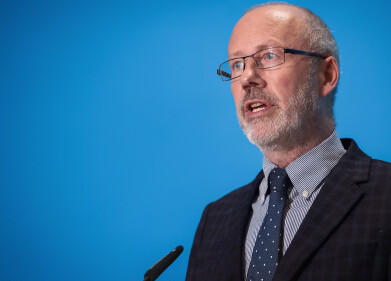-
 Artist’s impression of the SKA-Low telescope in Australia. These dipole antennas, which will number 131,072, will survey the radio sky in frequencies as low as 50Mhz. In the background are dishes of the ASKAP radio telescope, an SKA precursor (credit: SKAO)
Artist’s impression of the SKA-Low telescope in Australia. These dipole antennas, which will number 131,072, will survey the radio sky in frequencies as low as 50Mhz. In the background are dishes of the ASKAP radio telescope, an SKA precursor (credit: SKAO)
News
UK plays major role on SKAO Software Development
May 05 2022
More than £15 million has been awarded to UK institutions which are delivering the crucial software ‘brain’ of the Square Kilometre Array Observatory (SKAO), the world’s largest radio telescope, set to explore the evolution of the early universe.
From its Jodrell Bank UK headquarters, the SKAO will oversee the delivery and operations of two complementary arrays comprising 197 radio telescope dishes located in South Africa; and more than 130,000 low-frequency antennas in Western Australia.
Underpinning these instruments is powerful software guiding the telescopes’ exploration through space, diagnosing any issues and translating the telescope signals into useable data from which discoveries can be made. Having already played a vital role in software development during the design phase, the UK is now set to continue leading this area as the telescopes are constructed.
This includes the development of the science data processor and analysis software required to process the extreme rates of raw data from the SKA telescopes into science outputs, led by software developers from the University of Cambridge, STFC RAL Space and University of Oxford.
The UK ATC is also heading development of the Observatory Science Operations systems as part of the Indian-led Observatory Monitoring and Control software package. The universities of Manchester and Oxford, alongside STFC’s Technology Department and Daresbury Laboratory are part of the team leading designing the Monitor, Control and Calibration Subsystem (MCCS), that cntrols the hardware and software components of the individual elements of the low-frequency telescope, along with management and calibration of the observations.
Astronomers and software engineers at the universities of Manchester and Oxford are also leading on development of the powerful, precise pulsar search subsystem for both the low and mid-frequency telescopes, which will enable the telescopes to be used to search thousands of positions on the sky at once to identify large numbers of new pulsars. It will effectively create a galaxy-scale gravitational wave detector.
As one of the largest scientific endeavours in history, the SKAO brings together more than 500 engineers and 1,000 scientists in more than 20 countries.
Construction is expected to be completed by the end of the decade, with the telescopes anticipated to operate for over 50 years.
More information online
Digital Edition
Lab Asia Dec 2025
December 2025
Chromatography Articles- Cutting-edge sample preparation tools help laboratories to stay ahead of the curveMass Spectrometry & Spectroscopy Articles- Unlocking the complexity of metabolomics: Pushi...
View all digital editions
Events
Jan 21 2026 Tokyo, Japan
Jan 28 2026 Tokyo, Japan
Jan 29 2026 New Delhi, India
Feb 07 2026 Boston, MA, USA
Asia Pharma Expo/Asia Lab Expo
Feb 12 2026 Dhaka, Bangladesh


















